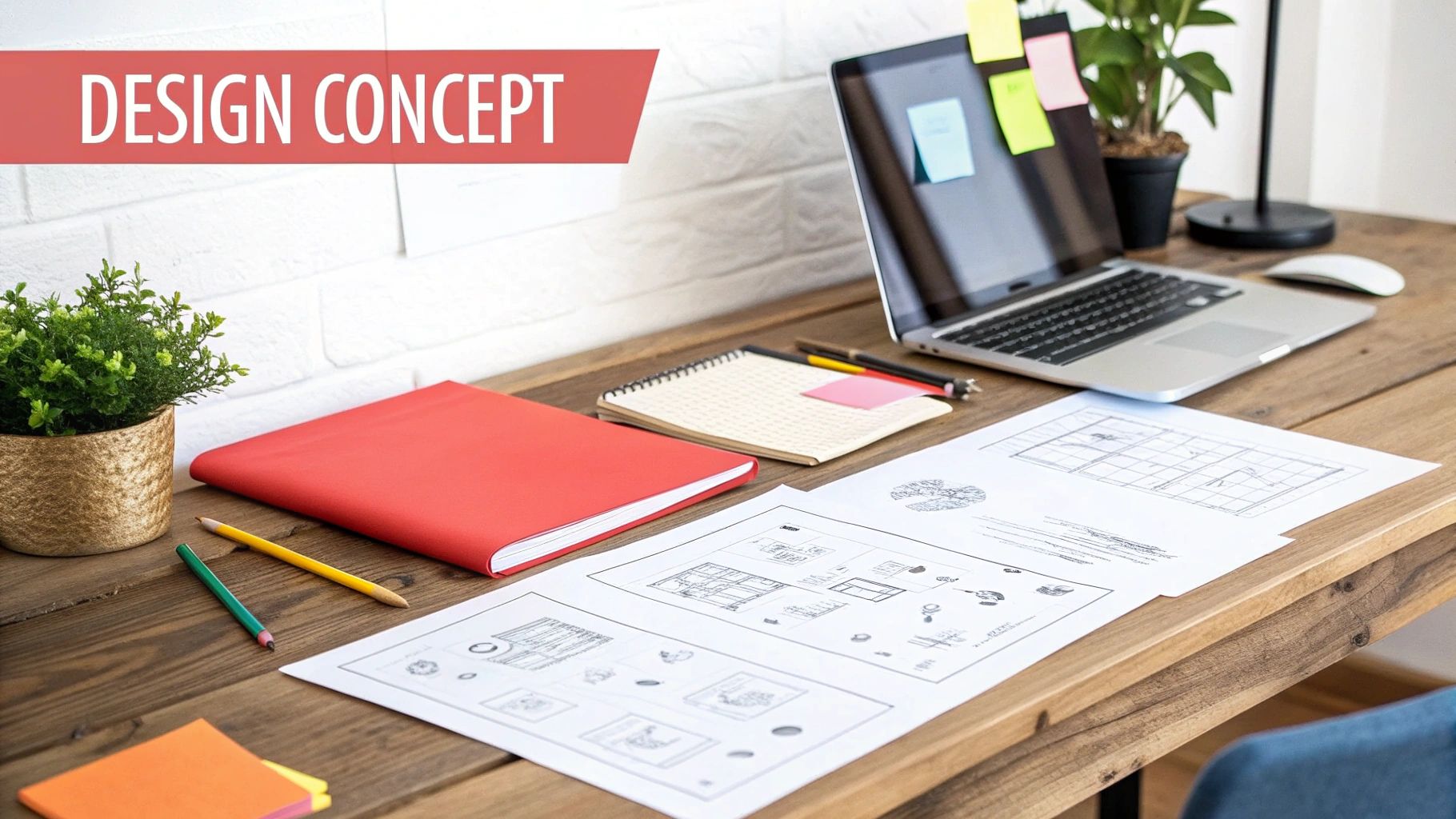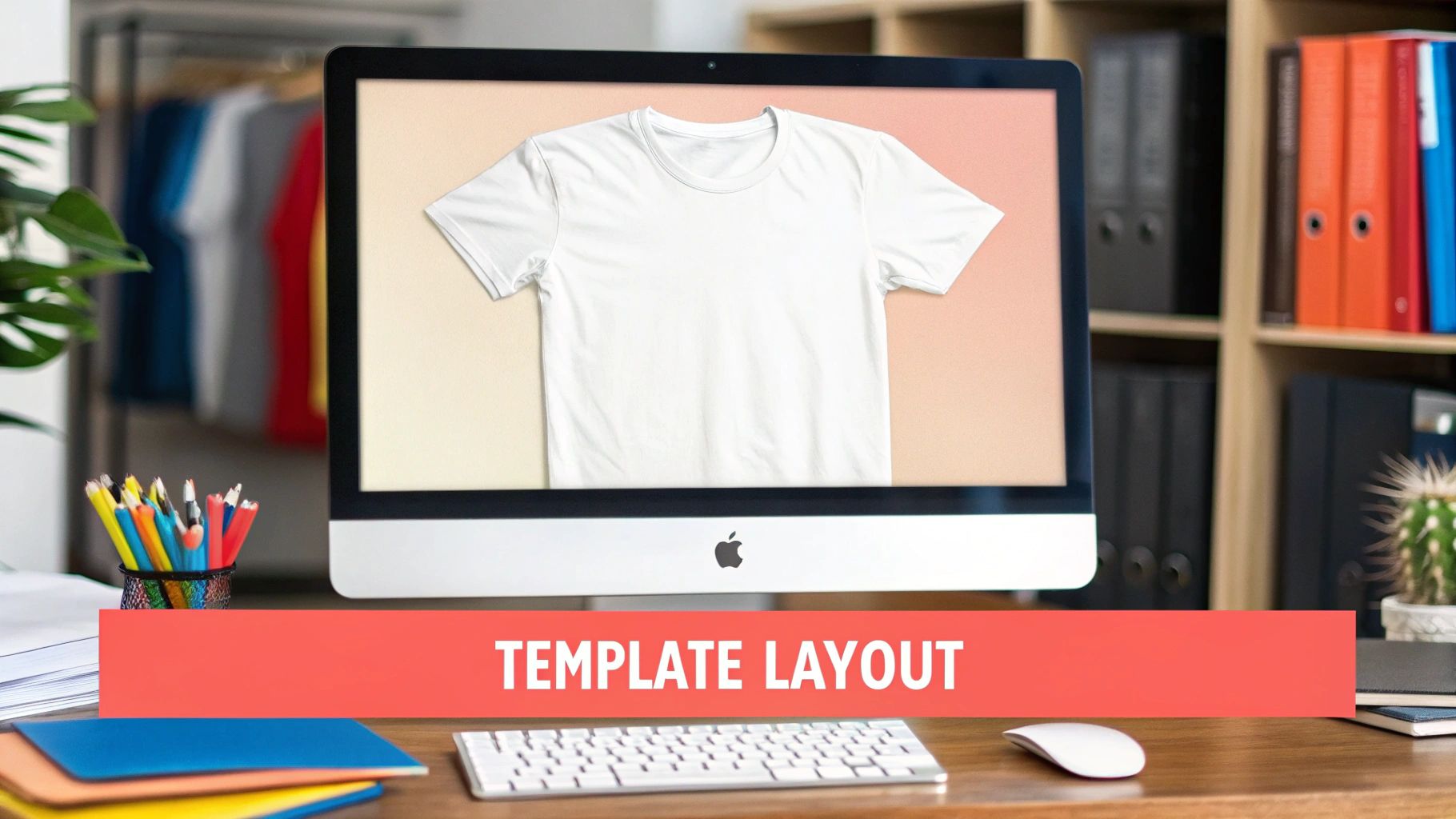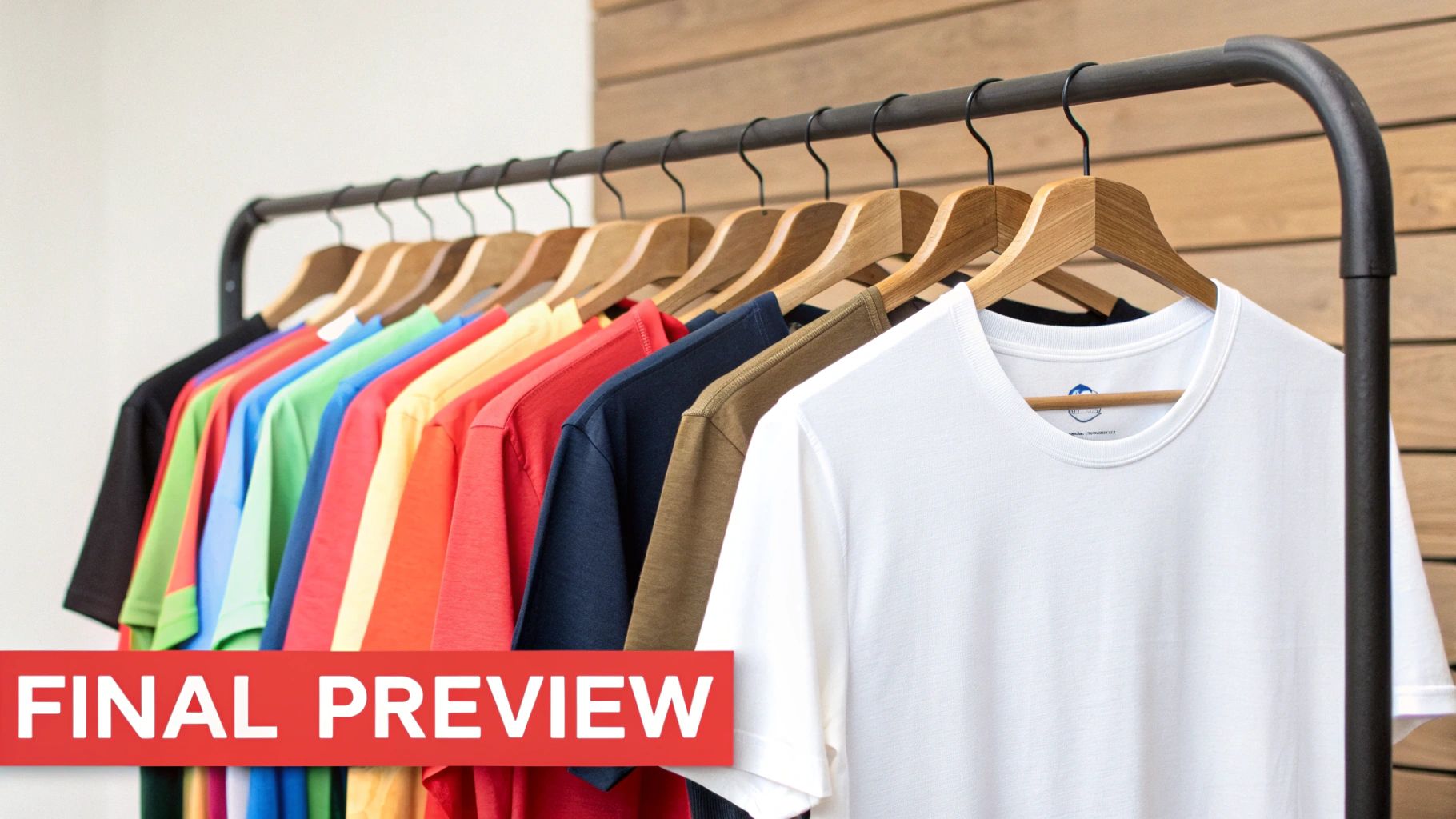The Foundation: Understanding T-Shirt Templates That Work

Creating a t-shirt template isn't as simple as placing a design onto a digital shirt. It requires understanding the essential elements that make a template professional and ready for production. These elements ensure your design translates flawlessly from digital to physical garment. A poorly designed template can result in misaligned prints, artwork cut-offs, and colors that don't match your original vision.
Key Elements of a Successful Template
Understanding dimensions is crucial. Your template dimensions must perfectly match the t-shirt size. A template for a small won't work for a 3XL.
You also need bleed areas. This extra space around your design prevents gaps at the print's edges, even with minor misalignments during production.
The safe zone is another vital component. This area within the template is where the core elements of your design should reside. Keeping key details within the safe zone prevents them from being trimmed or obscured during printing. This ensures important design features remain intact on the final product. For more information, check out this resource: How to master template creation.
Printing Methods and Template Considerations
Different printing methods have specific template requirements. Screen printing, often used for bulk orders, may require separate templates for each color.
Direct-to-Garment (DTG) printing, ideal for complex designs, handles intricate color gradients within a single template. Direct-to-Garment Printing offers more flexibility in design complexity.
Sublimation printing, used for all-over prints and vibrant colors, needs specific file formats and color profiles. Sublimation Printing is known for its vibrant and long-lasting results. The personalized apparel market is booming, with custom t-shirt printing expected to reach $17.27 billion by 2032, up from $9.23 billion in 2023. This growth highlights the importance of professional template design. Learn more about the growth of the t-shirt market.
A well-designed t-shirt template is the foundation of a successful print. Understanding these key elements prevents costly errors and allows you to create high-quality merchandise. By mastering template creation, your designs will transition seamlessly from concept to reality.
Essential Tools: Selecting the Right Software for Your Templates

After laying the foundation for a solid t-shirt template, choosing the right software is key. Your software choice significantly impacts your design process, influencing the final product and your workflow. This section guides you through selecting the best tools for creating those templates. The right software can elevate your designs to a professional level.
Key Features For Apparel Design Software
Several features are essential for t-shirt template design. Vector capability is crucial. Vector graphics, unlike raster images, scale without quality loss, ensuring crisp designs regardless of the t-shirt size.
Color accuracy is also vital. Robust color management helps avoid discrepancies between your digital design and the final printed product. Precise color tools minimize surprises.
Finally, effective layer control simplifies complex designs. It allows easy editing and adjustments without affecting other template parts. Organized layers also improve collaboration with printers.
Evaluating Software Options: A Comparative Look
Many software options cater to different skill levels and budgets. Adobe Illustrator offers powerful features, but has a higher learning curve and price.
For budget-friendly options, Affinity Designer provides excellent vector editing at a lower cost. Inkscape is a free, open-source option with a robust vector graphics feature set.
For beginners, Canva has a user-friendly interface with pre-made templates and drag-and-drop functionality. While less powerful than dedicated vector programs, Canva suits simple designs.
The following table compares these software options, highlighting their strengths and weaknesses. This helps you find the right fit for your needs and create a t-shirt template that truly shines:
T-Shirt Design Software Comparison: A comprehensive comparison of popular software options for creating t-shirt templates
| Software | Price | Skill Level | Vector Support | Template Library | Best For |
|---|---|---|---|---|---|
| Adobe Illustrator | Paid (Subscription) | Advanced | Yes | Limited | Professionals, complex designs |
| Affinity Designer | Paid (One-time) | Intermediate | Yes | Growing | Budget-conscious designers, vector graphics |
| Inkscape | Free | Intermediate | Yes | Community-driven | Beginners, open-source enthusiasts |
| Canva | Freemium | Beginner | Limited | Extensive | Simple designs, quick creation |
Choosing the right software impacts the entire process, from initial design to the final print. Selecting software aligned with your technical skills and budget is crucial for success. The next step is using that software to transform a blank canvas into the perfect t-shirt template.
From Blank Canvas to Perfect Template: Your Step-by-Step Guide
You've chosen your design software. Now, let's craft your t-shirt template. This guide walks you through creating a production-ready template, ensuring your design looks its best on fabric.
Setting Up Your Document
First, set the correct document size. This should match the t-shirt size you're designing. A small t-shirt needs different dimensions than a large. Next, set the resolution to 300 DPI for sharp, high-quality prints. Selecting the correct color mode is crucial for accurate color. Use CMYK for print and RGB for digital.
Building Your Template: Layers, Guides, and Components
Organize your template using labeled layers. A dedicated layer for your design, one for the base shirt, and separate layers for extra elements (like labels) make editing easy. Accurate guides are key for proper placement. Use rulers and guides within your software to mark the safe zone. This prevents important design elements from being trimmed during printing. Incorporate production-ready components like color separations for screen printing early on to avoid issues later.
Adapting to Different Shirt Colors and Sizes
A versatile template saves time. Design yours to work on various shirt colors without needing a complete redesign. Using transparency and color separation techniques ensures your design looks great on both light and dark backgrounds. Consider how your design scales across sizes, from youth to adult. A centered design on a small may need adjustments to stay centered on a larger size. Check out our sitemap for more resources on design and templates.
Measurements and Placement: Precision Matters
Precise measurements are essential. Use a sizing chart that matches the t-shirt brand and style you are using. Note how placement changes across different cuts like classic, slim fit, or v-neck. Small changes in neckline or sleeve length can affect your design's position, especially near the edges. Interestingly, China's t-shirt production dominance, with $5.92 billion in revenue in 2024, impacts template creation. Their cost-effective manufacturing allows for rapid prototyping, benefiting both brands and individual designers. Find more statistics here. Following these steps creates a professional t-shirt template, setting the stage for a high-quality product. A well-made template is an investment in your design's success, minimizing problems and maximizing visual impact.
Design Principles That Make T-Shirt Templates Stand Out

A technically sound t-shirt template is essential. But great design principles are what truly make a template shine. This means understanding how your design interacts with the garment itself. Key factors include color, typography, and the overall composition. These elements elevate your template from simply functional to something truly fantastic.
The Psychology of Color and Fabric
Color choice significantly impacts a t-shirt’s appeal. Color psychology plays a major role. Warm colors evoke energy and excitement, while cool colors project calmness and serenity.
For instance, a vibrant red design might be perfect for an activewear brand. A serene blue, on the other hand, would be a better fit for a yoga or meditation line. When designing your t-shirt template, consider your target audience and their preferences. Understanding body shapes and how clothing complements them is also important. A helpful resource for this is the body shape clothing guide.
The interaction of ink with different fabric colors is another crucial factor. A light design on a dark shirt requires different technical approaches compared to a dark design on a light shirt. Testing your design on various fabric colors is always recommended.
Typography That Works on Fabric
Typography plays a vital role in any t-shirt design. Readability is paramount. Your design should be easily legible, both up close and from a distance. This requires careful font selection.
A bold sans-serif font might be a great choice for a short, impactful slogan. Meanwhile, a more delicate script font could be suitable for a brand name or a more intricate design. Font size and placement are equally important. Larger fonts command attention, while smaller fonts can add subtle details. The placement should complement the t-shirt’s shape and flatter the wearer.
Composition: Thinking in Three Dimensions
Composition for t-shirt design is unique. Unlike flat artwork, your design wraps around a three-dimensional form. This adds a layer of complexity to the design process.
A balanced, visually appealing design on a flat screen might look distorted when printed on a t-shirt. Consider how the design flows across the chest, back, and sleeves. A centered design works well for logos, while a design that follows the contours of the body can create a more dynamic look.
Avoid overcrowding the design. Negative space is essential. It gives the eye a place to rest and enhances the design’s impact. This allows the design to "breathe" and prevents a cluttered, overwhelming look.
The following table summarizes key design considerations for creating effective t-shirt templates:
T-Shirt Design Elements: Impact and Best Practices
| Design Element | Impact on Wearability | Technical Considerations | Best Practices |
|---|---|---|---|
| Color | Affects mood, brand identity, and visual appeal | Ink/fabric interaction | Consider color psychology and test on different fabric bases |
| Typography | Impacts readability and brand messaging | Font choice, size, and placement | Prioritize legibility and placement that flatters the wearer |
| Composition | Determines how the design interacts with the body's shape | Balance, negative space, 3D thinking | Design for the curves of the body, avoid clutter |
By understanding these design principles and how they interact, you can create t-shirt templates that not only look great on screen but also translate beautifully onto fabric. This thoughtful approach results in a more polished and professional final product.
Production-Ready: Preparing Templates That Printers Love
A great t-shirt design can easily lose its impact if it's not properly prepared for printing. This section focuses on creating printer-friendly files, bridging the gap between your creative vision and a polished final product. We'll explore optimizing your t-shirt template for different production methods, ensuring a seamless journey from digital design to a tangible garment.
Optimizing File Formats and Resolution
Different printing methods require different file formats. For screen printing, vector files like .AI or .EPS are ideal because they maintain image quality regardless of scaling. Adobe Illustrator is a popular program for creating these types of files. DTG (Direct-to-Garment) printing often uses .PNG or .PDF files, supporting complex designs with transparent backgrounds. Understanding these distinctions is key to high-quality prints.
Your template's resolution is also crucial. Aim for at least 300 DPI (dots per inch). This ensures crisp, clear prints, avoiding blurry or pixelated results. Lower resolutions can lead to disappointing prints, especially with detailed designs.
Color Separation and Transparency
Color separation is essential for screen printing, where each color is printed individually. Properly separating colors in your template simplifies the printing process and ensures accurate color reproduction.
For designs incorporating transparent elements, save your files in formats that preserve transparency, such as .PNG or .PDF. This is particularly important for DTG printing, where transparency allows the shirt color to show through the design. If transparency isn't handled properly, the final print may not match your design.
Creating Accurate Mockups
Mockups are invaluable for visualizing your design on an actual t-shirt. They help identify potential issues before printing, saving time and money. Use mockup generators or software like Placeit that accurately represent the t-shirt's fabric and drape. This gives you a realistic preview of the final product. A well-crafted mockup helps you catch problems early on, like misplaced designs or unexpected color interactions. You might find this article helpful: How to master t-shirt creation with AI-powered tools.
Navigating Printer Specifications
Every printer has specific requirements for file formats, color modes (CMYK for print), and bleed areas. Consult your printer's guidelines before submitting your design. This proactive step prevents production errors and ensures your design is printed accurately the first time. Overlooking these specifications can result in costly reprints or a final product that doesn't meet your expectations.
Pre-Flight Checklist: Ensuring a Smooth Print Run
A final check before sending your template to the printer is crucial. This pre-flight checklist helps avoid common problems:
- File format: Confirm it matches the printing method.
- Resolution: Verify it's at least 300 DPI.
- Color mode: Ensure it's CMYK for printing.
- Bleed area: Double-check it meets the printer's specifications.
- Transparency: Confirm it's handled correctly.
- Mockup approval: Sign off on the final mockup to guarantee accuracy.
By following these steps, you'll transform your creative vision into a production-ready template, resulting in high-quality printed t-shirts that accurately represent your design. This careful preparation minimizes errors and maximizes the impact of your work.
Elevate Your Templates: Advanced Techniques From the Pros

Want to create t-shirt templates that truly impress? Taking your designs to the next level involves mastering some key techniques. This section explores advanced methods used by seasoned designers to create visually appealing apparel that stands out. These techniques can significantly boost the perceived value of your work.
Adding Depth and Texture: Distressing, Vintage Treatments, and More
Distressing is a powerful technique that adds character. Think simulated wear and tear, giving your designs a vintage vibe. You can achieve this effect using digital brushes and filters in design software like Adobe Photoshop.
Adding textures like grunge or watercolor effects can also bring your designs to life. This creates a more tactile, layered look, adding depth and visual interest to your t-shirt templates.
Vintage treatments are another excellent way to elevate your designs. This involves applying filters and color adjustments to create a faded, retro appearance. Experiment with different combinations to achieve unique vintage effects.
Multi-Location Printing: Maintaining Design Integrity
Creating multi-location prints that look cohesive requires planning. Your design should flow smoothly across different parts of the shirt – front, back, and sleeves.
Consider how the design breaks across seams and folds. Maintaining visual consistency is crucial for a polished, professional result. For instance, a large graphic on the front could connect with a smaller continuation on the back.
Incorporating Specialty Printing: Metallic Finishes and Dimensional Effects
Specialty printing techniques can truly elevate your designs. Metallic finishes add a touch of luxury, while dimensional effects provide a unique tactile experience.
Preparing your templates for these techniques requires careful layer management. For metallic finishes, designate specific layers for the metallic inks. For dimensional prints, precisely define the raised areas within your template.
Advanced Mockup Creation: Achieving Hyper-Realism
Mockups are essential for visualizing your finished product. They also help identify potential issues before printing. Advanced mockup creation techniques, often involving specialized software or Photoshop actions, produce hyper-realistic results.
These high-quality mockups showcase your designs with maximum impact. They look almost identical to the final printed garment, making them ideal for selling your designs or pitching to clients.
Template Optimization for Print-on-Demand Platforms
If you're designing for commercial purposes, optimizing your templates for print-on-demand platforms is essential. These platforms often have specific formatting requirements and file size limits.
Best practices include using the correct color profiles (usually sRGB) and adhering to the platform’s size and resolution guidelines. Tailoring your templates to these specifications will ensure a smooth printing process.
By mastering these advanced techniques, you can create t-shirt templates that are not only production-ready but also stand out from the crowd. Develop these skills to produce designs that are visually compelling and technically sound.
Ready to transform your ideas into unique, high-quality apparel? ThisShirtExists.com uses AI to help you create stunning custom designs for t-shirts, hoodies, and more. Visit ThisShirtExists.com and bring your imagination to life!


